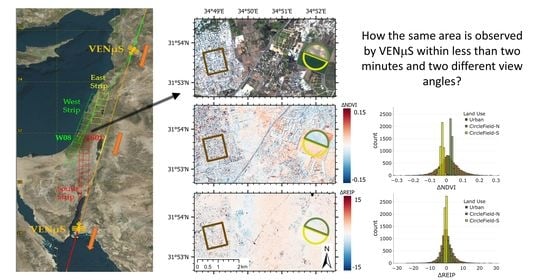VENµS-Derived NDVI and REIP at Different View Azimuth Angles
Abstract
:1. Introduction
2. Materials and Methods
2.1. VENµS Data Collection
2.2. Study Area
2.3. Vegetation Indices and Albedo
2.4. Pixel Subtraction
2.5. Change Vector Analysis
3. Results and Discussion
4. Conclusions
Author Contributions
Funding
Institutional Review Board Statement
Informed Consent Statement
Data Availability Statement
Conflicts of Interest
References
- Dedieu, G.; Karnieli, A.; Hagolle, O.; Jeanjean, H.; Cabot, F.; Ferrier, P.; Yaniv, Y. A Joint Israeli–French Earth Observation Scientific Mission with High Spatial and Temporal Resolution Capabilities. In Proceedings of the 4th ESA CHRIS/Proba Work, ESRIN, Frascati, Italy, 19–21 September 2006; pp. 19–21. [Google Scholar]
- Schaepman-Strub, G.; Schaepman, M.E.; Painter, T.H.; Dangel, S.; Martonchik, J.V. Reflectance quantities in optical remote sensing—definitions and case studies. Remote Sens. Environ. 2006, 103, 27–42. [Google Scholar] [CrossRef]
- Roy, D.P.; Zhang, H.K.; Ju, J.; Gomez-Dans, J.L.; Lewis, P.E.; Schaaf, C.B.; Sun, Q.; Li, J.; Huang, H.; Kovalskyy, V. A general method to normalize Landsat reflectance data to nadir BRDF adjusted reflectance. Remote Sens. Environ. 2016, 176, 255–271. [Google Scholar] [CrossRef] [Green Version]
- Mueller, N.; Lewis, A.; Roberts, D.; Ring, S.; Melrose, R.; Sixsmith, J.; Lymburner, L.; McIntyre, A.; Tan, P.; Curnow, S.; et al. Water observations from space: Mapping surface water from 25 years of Landsat imagery across Australia. Remote Sens. Environ. 2016, 174, 341–352. [Google Scholar] [CrossRef] [Green Version]
- Liu, Y.; Hill, M.; Zhang, X.; Wang, Z.; Richardson, A.D.; Hufkens, K.; Filippa, G.; Baldocchi, D.D.; Ma, S.; Verfaillie, J.; et al. Using data from Landsat, MODIS, VIIRS and PhenoCams to monitor the phenology of California oak/grass savanna and open grassland across spatial scales. Agric. For. Meteorol. 2017, 237–238, 311–325. [Google Scholar] [CrossRef]
- Tucker, C.J. Red and photographic infrared linear combinations for monitoring vegetation. Remote Sens. Environ. 1979, 8, 127–150. [Google Scholar] [CrossRef] [Green Version]
- Martimort, P.; Fernandez, V.; Kirschner, V.; Isola, C.; Meygret, A. Sentinel-2 MultiSpectral imager (MSI) and calibra-tion/validation. Int. Geosci. Remote Sens. Symp. 2012, 6999–7002. [Google Scholar]
- Herrmann, I.; Pimstein, A.; Karnieli, A.; Cohen, Y.; Alchanatis, V.; Bonfil, D.J. LAI assessment of wheat and potato crops by VENμS and Sentinel-2 bands. Remote Sens. Environ. 2011, 115, 2141–2151. [Google Scholar] [CrossRef]
- Clevers, J.G.P.W.; Gitelson, A.A. Remote estimation of crop and grass chlorophyll and nitrogen content using red-edge bands on Sentinel-2 and -3. Int. J. Appl. Earth Obs. Geoinf. 2013, 23, 344–351. [Google Scholar] [CrossRef]
- Hagolle, O.; Huc, M.; Desjardins, C.; Auer, S.; Richter, R. MAJA Algorithm Theoretical Basis Document. Development 2017, 1–39. Available online: http://tully.ups-tlse.fr/olivier/maja_atbd/raw/master/atbd_maja.pdf (accessed on 15 December 2021).
- Robinove, C.J.; Chavez, P.S.; Gehring, D.; Holmgren, R. Arid land monitoring using Landsat albedo difference images. Remote. Sens. Environ. 1981, 11, 133–156. [Google Scholar] [CrossRef]
- Johnson, R.D.; Kasischke, E.S. Change vector analysis: A technique for the multispectral monitoring of land cover and condition. Int. J. Remote Sens. 1998, 19, 411–426. [Google Scholar] [CrossRef]
- Karnieli, A.; Qin, Z.; Wu, B.; Panov, N.; Yan, F. Spatio-Temporal Dynamics of Land-Use and Land-Cover in the Mu Us Sandy Land, China, Using the Change Vector Analysis Technique. Remote Sens. 2014, 6, 9316–9339. [Google Scholar] [CrossRef] [Green Version]
- Zanchetta, A.; Bitelli, G.; Karnieli, A. Monitoring desertification by remote sensing using the Tasselled Cap transform for long-term change detection. Nat. Hazards 2016, 83, 223–237. [Google Scholar] [CrossRef]
- Bayarjargal, Y.; Karnieli, A.; Bayasgalan, M.; Khudulmur, S.; Gandush, C.; Tucker, C.J. A comparative study of NO-AA-AVHRR derived drought indices using change vector analysis. Remote Sens. Environ. 2006, 105, 9–22. [Google Scholar] [CrossRef]
- Curzi, G.; Modenini, D.; Tortora, P. Large Constellations of Small Satellites: A Survey of Near Future Challenges and Missions. Aerospace 2020, 7, 133. [Google Scholar] [CrossRef]




| Bands | Central Wavelength (nm) | Bandwidth (nm) | Main Application |
|---|---|---|---|
| B1 | 423.9 | 40 | Atmospheric Correction, Water |
| B2 | 446.9 | 40 | Aerosols, Clouds |
| B3 | 491.9 | 40 | Atmospheric Correction, Water |
| B4 | 555.0 | 40 | Land |
| B5 | 619.7 | 40 | Vegetation Indices |
| B6 | 619.7 | 40 | DEM, Image Quality |
| B7 | 666.2 | 30 | Red Edge |
| B8 | 702.0 | 24 | Red Edge |
| B9 | 741.1 | 16 | Red Edge |
| B10 | 782.2 | 16 | Red Edge |
| B11 | 861.1 | 40 | Vegetation Indices |
| B12 | 908.7 | 20 | Water Vapor |
| W08 | S01 | |||||
|---|---|---|---|---|---|---|
| Apr. 18 | Jun. 27 | Sep. 11 | Apr. 18 | Jun. 27 | Sep. 11 | |
| View zenith angle (deg) | 35.29 | 35.54 | 35.29 | 30.10 | 30.31 | 30.13 |
| View azimuth angle (deg) | 25.88 | 27.16 | 25.77 | 179.15 | 177.41 | 179.26 |
| Solar zenith angle (deg) | 26.21 | 18.17 | 31.14 | 25.85 | 17.63 | 30.86 |
| Solar azimuth angle (deg) | 138.39 | 112.50 | 146.93 | 139.78 | 113.76 | 148.21 |
| Acquisition time (UTC) | 08:31:27 | 08:31:43 | 8:32:58 | 08:33:23 | 08:33:40 | 08:34:54 |
Publisher’s Note: MDPI stays neutral with regard to jurisdictional claims in published maps and institutional affiliations. |
© 2022 by the authors. Licensee MDPI, Basel, Switzerland. This article is an open access article distributed under the terms and conditions of the Creative Commons Attribution (CC BY) license (https://creativecommons.org/licenses/by/4.0/).
Share and Cite
Salvoldi, M.; Tubul, Y.; Karnieli, A.; Herrmann, I. VENµS-Derived NDVI and REIP at Different View Azimuth Angles. Remote Sens. 2022, 14, 184. https://doi.org/10.3390/rs14010184
Salvoldi M, Tubul Y, Karnieli A, Herrmann I. VENµS-Derived NDVI and REIP at Different View Azimuth Angles. Remote Sensing. 2022; 14(1):184. https://doi.org/10.3390/rs14010184
Chicago/Turabian StyleSalvoldi, Manuel, Yaniv Tubul, Arnon Karnieli, and Ittai Herrmann. 2022. "VENµS-Derived NDVI and REIP at Different View Azimuth Angles" Remote Sensing 14, no. 1: 184. https://doi.org/10.3390/rs14010184








